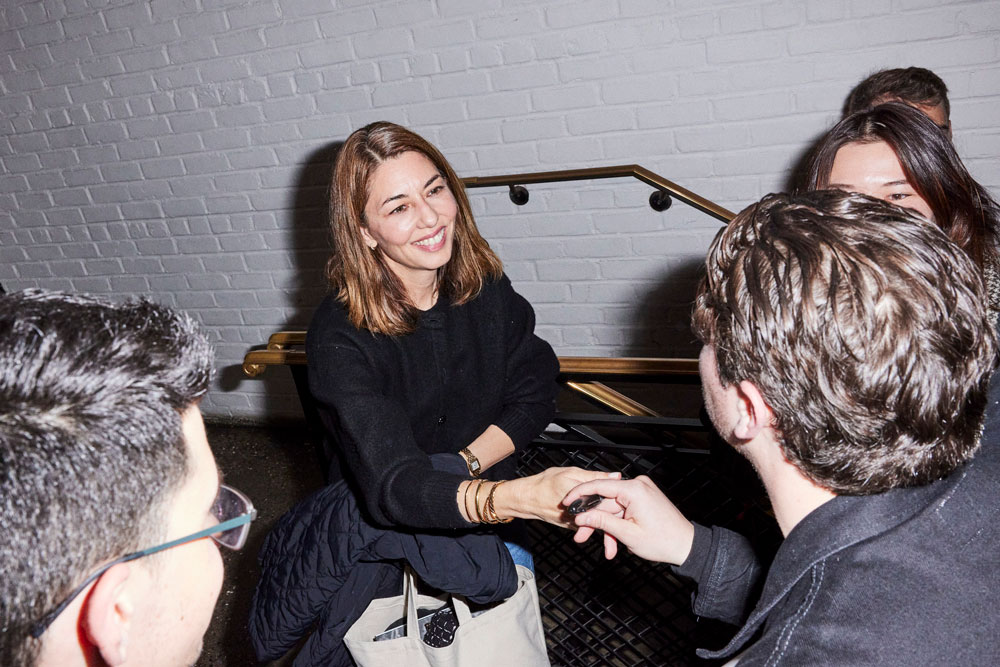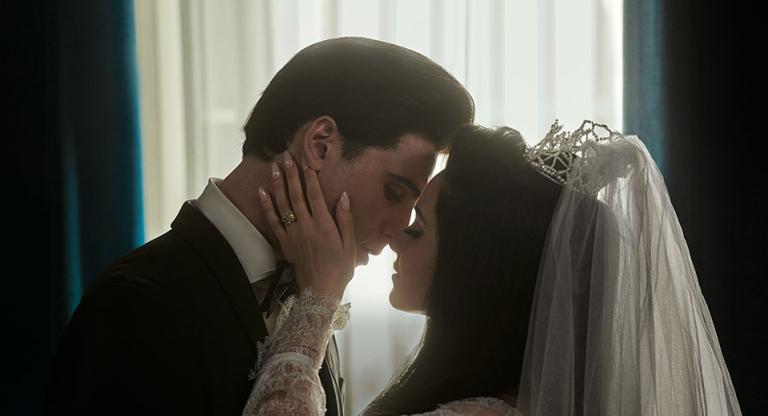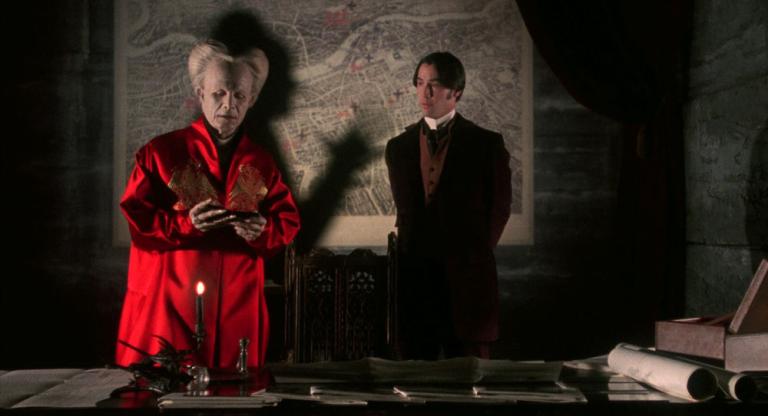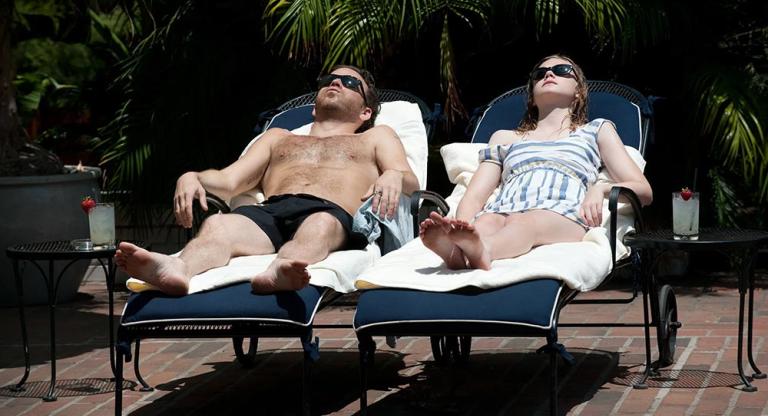My first encounter with the work of Sofia Coppola was seeing Lost in Translation (2003), which I discovered in my older siblings’ DVD collection. Soon after, I sought out The Virgin Suicides (1999) and then Marie Antoinette (2006). It was 2010, and I was a sophomore in high school, keenly interested in filmmaking. Coppola’s films became a touchstone for me, not only because of the way they looked and felt but also because of the way they depicted the experiences of young women. At that point, Coppola was the only female filmmaker I knew, and her successes as a director mattered to me, despite the obvious professional advantages of her last name. So, in January 2011, a week after Somewhere opened in theaters, when I saw a post on my Tumblr feed from the admin of sofiacoppola.tumblr.com expressing the need for someone to take over the blog, I jumped at the opportunity and became the admin for the internet’s premier Sofia Coppola fan site.
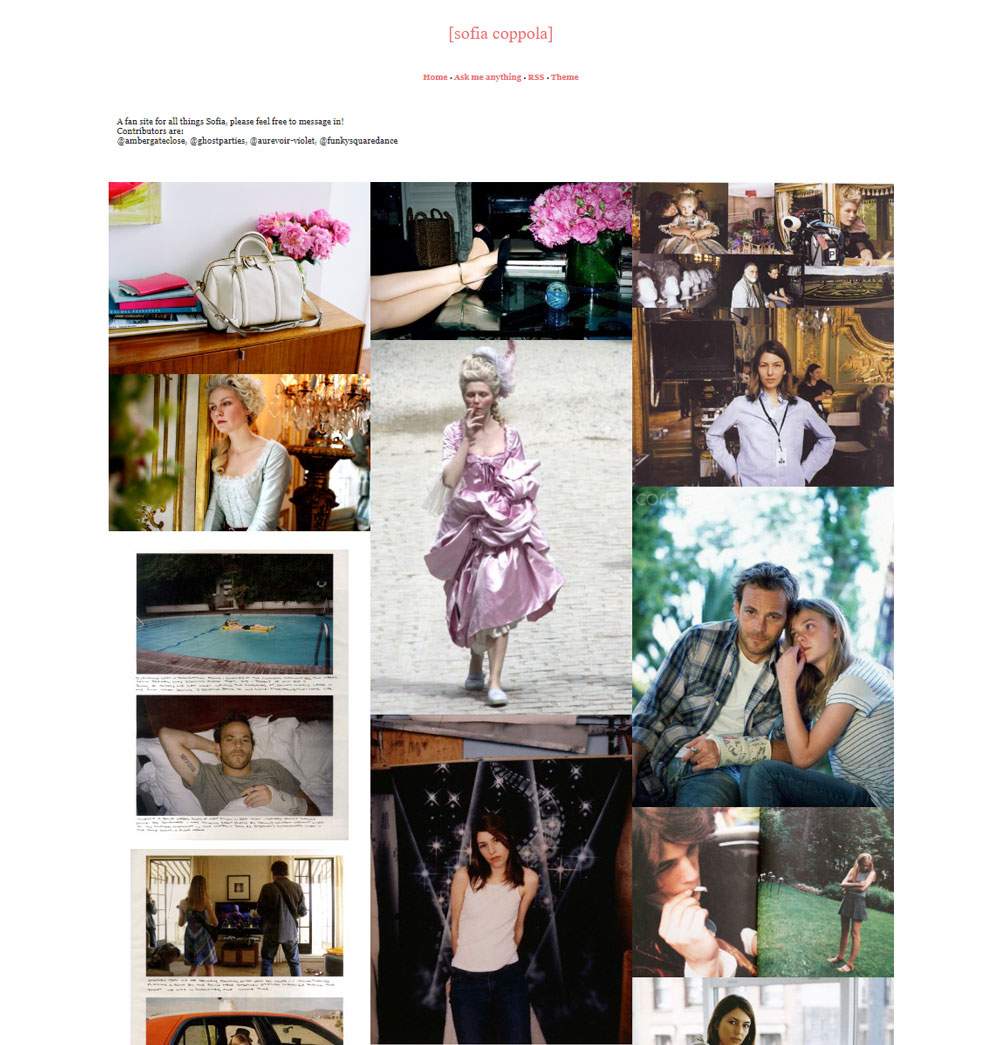
In the mid-2010s, imagery and music from Sofia Coppola’s films had an overwhelming presence on the microblogging platform. As the admin for the fan site, I made an effort to track down as much new content about Coppola as I could find to upload for our eight thousand followers, whether this meant buying magazines to scan interviews or setting alerts for any new paparazzi images posted online. I learned how to use Photoshop to create collages and gifs that would garner thousands of notes (the main statistic for activity on a Tumblr post). Stills of Scarlett Johansson’s transparent pink briefs from Lost In Translation, a photograph of Kirsten Dunst in a Rococo gown and wig holding a MacBook, and gifs of the Lisbon sisters lounging in their bedroom circulated endlessly. Even images of a young Sofia herself were popular, whether in paparazzi shots from the ’90s alongside Keanu Reeves or on set holding a pink can of Coppola Winery’s Sofia Rosé. Sofia Coppola was beloved on this corner of the internet, and quotes and gifs from her films became fixtures of what Gen Z commentators would later dub the “2014 Tumblr Girl” aesthetic, typified by its association with melancholic themes and indie music. The director and her films made for prime reference material for this wave of internet fandom. A Tumblr blog could be like the bedroom of a Coppola protagonist, a space for private expression and exploration.
Though my days of Tumblr blogging are now long past, I recently had the opportunity to revisit the world of these films at the highly anticipated “Sofia Coppola Selects” event at Metrograph. The evening included a screening of Coppola’s latest film, Priscilla (2023), followed by a Q&A with the filmmaker, then a screening of Todd Haynes’s Safe (1995), which Coppola introduced. In the lobby, copies of the forthcoming Sofia Coppola Archive: 1999–2023 lined the walls of the concession area, casting a baby pink glow over the crowd. Out in November, the book is Coppola’s first, featuring 500 pages of ephemera from her now eight features. The evening offered a rare peek into the working process of one of Hollywood’s more private and media-shy directors.
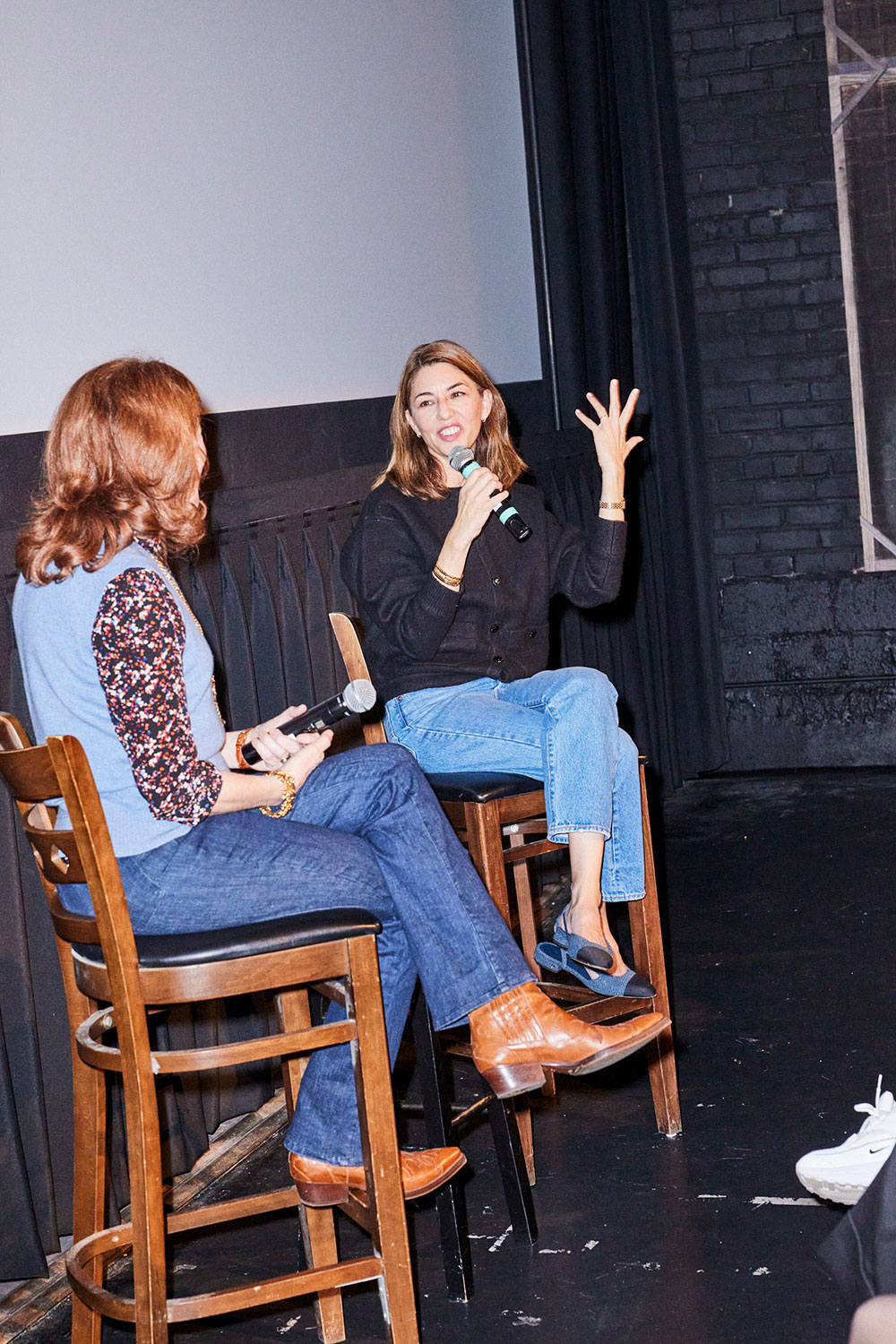
In the Q&A, the moderator, critic Stephanie Zacharek, noted that Coppola’s films seem to have a newfound popularity with younger audiences, especially those that weren’t initially received well by critics. Coppola expressed her happiness that the work has continued to reach audiences despite early setbacks. In 2023, her work’s cultural effects have never been more evident nor more celebrated. In the last year, we have seen Coppola’s influence across the internet, from her own daughter’s TikTok hijinks going viral to Olivia Rodrigo sporting a vintage ’90s tee from Coppola’s short-lived Milkfed clothing line. In a recent interview, the “it-girl” Devon Lee Carlson cited Coppola’s work as a major source of inspiration for the patterned phone-case designs of her popular brand Wildflower Cases, and in September, i-D published an article on Coppola’s fans titled "Meeting Sofia Coppola stans in New York." At Metrograph, the director was greeted by an adoring audience that hung on her every word. In the lobby between screenings, I noticed more than one woman wearing a black choker with a silver heart on it, mimicking the one worn by Cailee Spaeny in Priscilla. They and others pored over the new book and its many pages of mood boards, behind-the-scenes photos, and reproductions of personal ephemera. Flipping through Sofia Coppola Archive is the closest to a physical experience of scrolling sofiacoppola.tumblr.com that will probably ever exist.
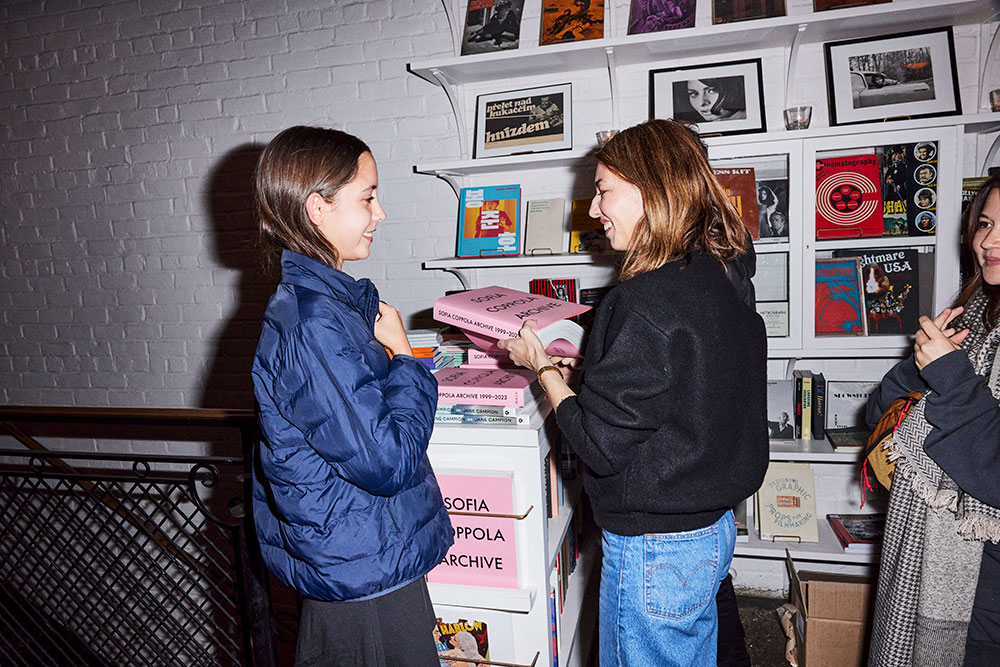
Coppola has often repeated that one of the main reasons she began making films in the first place was because she “didn’t see any films told from the perspective of a young girl,” and very few that were done artfully or with an attention to softer aesthetics. While her distinctive style has sometimes led to a critical dismissal of her films—‘pretty with no substance’—these qualities are exactly what have given Coppola’s films and characters a lasting presence. In the foreword to Hannah Strong's book Sofia Coppola: Forever Young, Alice Rohrwacher compares a Coppola film to a garden. The visuals and aromas are initially overwhelming and entrancing, but when one is drawn closer they notice a small interaction between an insect and a flower. These small gestures, Strong writes, can encapsulate the emotions of a relationship, an injustice, everything. In Priscilla, we encounter a young girl who is equal parts naïve and precocious, self-possessed and adept at navigating complicated emotions. Throughout the film, her actions are never made to seem frivolous, whether she is picking out what dress to wear and adorning her walls with tabloid cutouts or withstanding the throes of an abusive relationship. Priscilla emerges from teenagehood as a confident young woman, though not unscathed. As is often the case in a Sofia Coppola film, girls and girlhood are shown with an earnestness that reveals adroitness rather than frivolity, strength rather than fragility.
In her book, Coppola writes that she “was worried that Priscilla would be too similar to Marie Antoinette,” noting the similarities between Priscilla’s life at Graceland to Marie Antoinette’s at Versailles. While the historical characters share certain qualities, namely their age and the scrutiny of the public eye, Coppola deftly creates two very distinct portraits of these women. Opulent settings and withdrawn upper-class characters have become hallmarks of Coppola’s films. In a letter to Antonia Fraser (the author of Marie Antoinette: A Journey, on which Coppola based her screenplay), which is featured prominently in Sofia Coppola Archive, the director writes,“I know I will be able to express how a girl experiences the grandeur of a palace, the clothes, parties, rivals, and ultimately having to grow up. I can identify with her role of coming from a strong family and fighting for her own identity.” Coppola’s perspective and experiences as a woman always come through in her direction.
Early in the Q&A, a glass bottle fell from someone’s armrest and shattered on the floor of the theater. Without hesitation, Coppola looked toward the scene and announced “Opa! That’s good luck,” with the instinct of someone well accustomed to putting people at ease. In her introduction of Sofia Coppola Archive, Lynn Hirschberg calls this Coppola’s “grace under pressure, of talent without unnecessary bombast.” This is the same type of coolness and ease that Coppola brings to all of her films. Priscilla in particular is an antidote to last year’s Elvis and this summer’s Barbie. Rather than protect her protagonists, Coppola lets them grow and evolve in complicated and realistic ways. The Elvis that we meet in Priscilla is seen only through the eyes of Priscilla. When discussing the casting of Spaeny, Coppola explained the need to find an actress that could realistically portray a 14-year-old girl as well a young woman in her twenties, and the importance that they depict the real-life age difference between Priscilla and Elvis responsibly. She explained the difficulty in achieving a tone that didn’t condone the relationship between Elvis and Priscilla but recognized its relevance for many young women. As Coppola noted in the Q&A, she remembers ‘talking to older men as a teenager and the feeling of being sophisticated.’
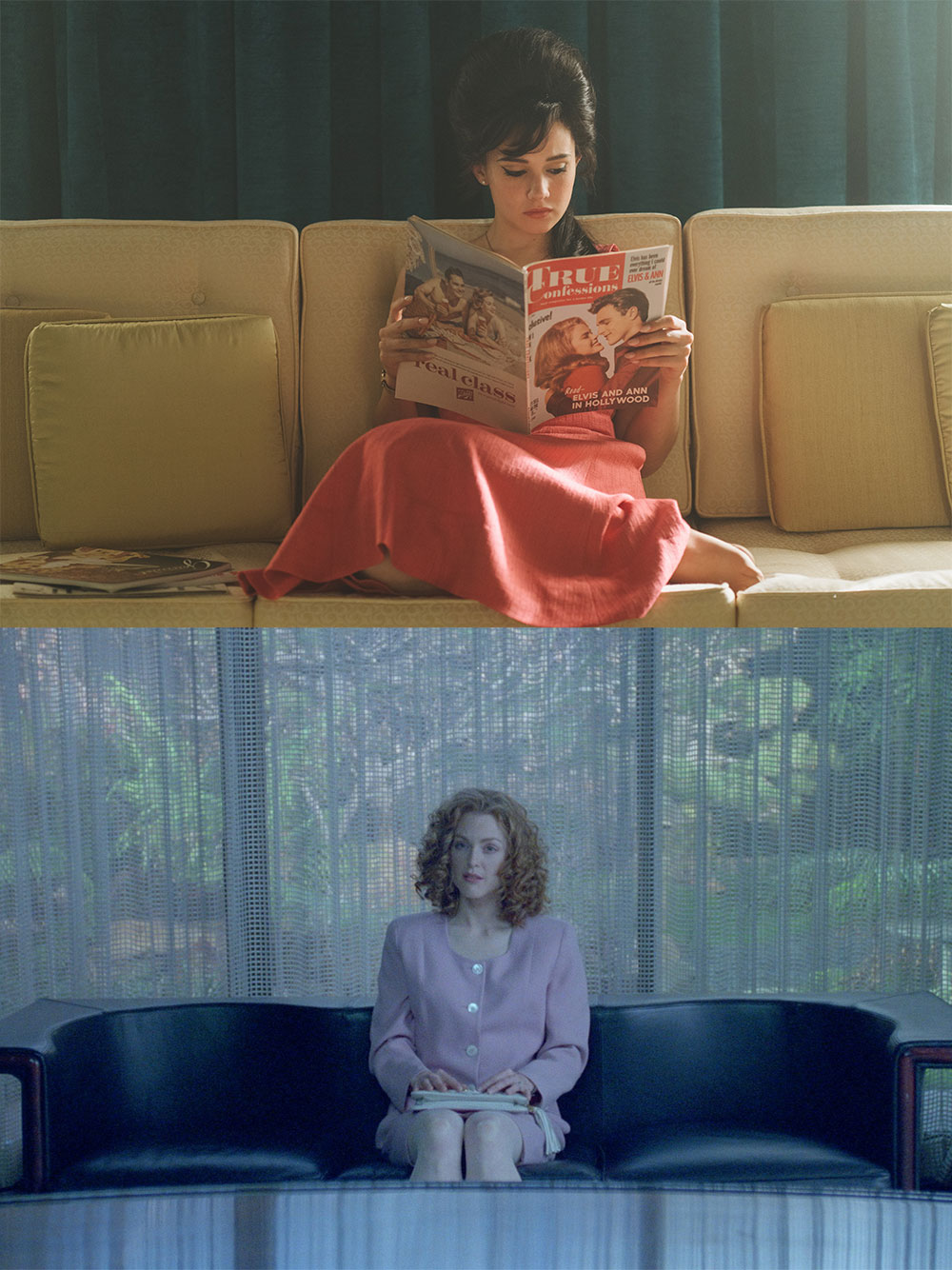
In her introduction, Coppola explained her love of Safe for its strange atmosphere and fixation on small details. She had paired them not for their similarities in characters or story, but in setting and tone. In truth, Priscilla and Julianne Moore’s Carol could not be more different as women, but Graceland and Safe’s suburban homes share a particularly heightened—even kitsch—design aesthetic that is over-the-top and yet feels void of personality. In Safe, Haynes recreates the postmodern furnishings of a ’90s upper-middle-class suburban home, each choice conveying a particular kind of understated affluence typical of the era. Coppola singled out a scene from the film in which Moore becomes unusually upset when the wrong color couch is delivered to her home. This, in part, sets the stage for Carol’s undoing. Similarly, in Priscilla, Coppola uses silent and naturally-lit close ups of plush pink rugs, tasseled curtains, and crystal chandeliers to emphasize the loneliness in Graceland’s grandeur. In her recreation of Graceland, Coppola looked towards William Eggleston’s 1984 photographs of the site, which capture a similar sense of emptiness. In both Priscilla and Safe, the homes and surroundings of the main characters are more than just a backdrop; they become a physical expression of the character’s inner struggles. In both films, women seek acceptance and the ability to change in a world where they feel out of place.
In the last entry in her book, Coppola writes about the production of Priscilla, “On this set, I totally felt in my element, doing what I love. I could see moments that felt like past films, but hopefully that’s now my style and all of my experience went into this one.” Watching Priscilla, I was reminded of how I felt the first time I watched a Sofia Coppola film. Though I have grown out of my fangirl phase, it is a world I will want to revisit again and again, finding something new in it as I grow and change as well.
Sofia Coppola Selects took place October 22 at Metrograph. Priscilla is now screening in wide release, and Sophia Coppola Archive is available from Mack Books.
